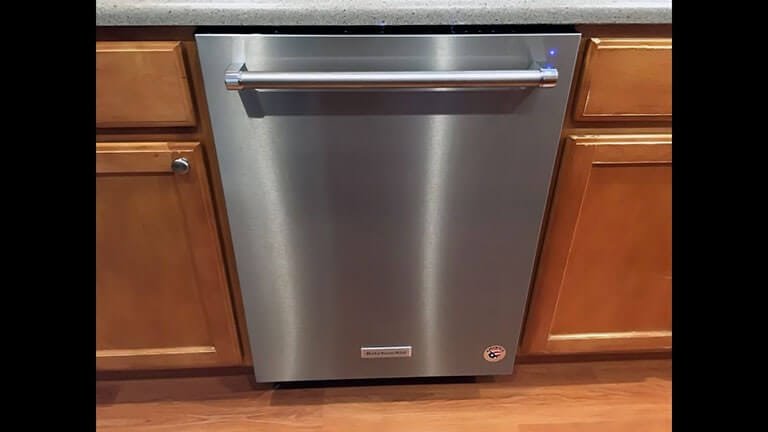Is your Kitchenaid dishwasher not filling with water? This issue can be frustrating.
You rely on your dishwasher to save time, so when it doesn’t work, it’s a big problem. A dishwasher that won’t fill with water might have several causes. It could be a simple problem, like a clogged filter, or something more complex, like a broken part.
Understanding the possible reasons can help you fix the issue quickly. In this post, we will explore the common causes and solutions for a Kitchenaid dishwasher not filling with water. By the end, you’ll have a better idea of what might be wrong and how to address it. Let’s get started!
Common Causes
A KitchenAid dishwasher not filling with water can be frustrating. Understanding the common causes helps you fix the issue. This guide breaks down the most typical problems. Let’s explore each cause with clear explanations.
Clogged Water Inlet Valve
A clogged water inlet valve is a frequent cause. This valve controls water flow into the dishwasher. Over time, debris can block the valve. This blockage prevents water from entering.
To check if the valve is clogged:
- Turn off the power and water supply.
- Locate the water inlet valve. It’s usually at the bottom of the dishwasher.
- Remove the valve and inspect it. Look for debris or mineral buildup.
- Clean the valve with a soft brush or replace it if needed.
Faulty Float Switch
The float switch monitors water levels inside the dishwasher. If it’s faulty, it may stop water from filling. The switch can get stuck or break.
To check the float switch:
- Turn off the power to the dishwasher.
- Open the dishwasher door and locate the float. It’s usually a plastic dome or cylinder at the bottom.
- Lift the float to see if it moves freely. If it sticks, clean around it.
- If the float moves freely, check the float switch. It’s located underneath the float inside the dishwasher.
- Use a multimeter to test the float switch for continuity. Replace the switch if it’s faulty.
These steps will help you diagnose and fix a KitchenAid dishwasher not filling with water.
Initial Checks
Experiencing a Kitchenaid dishwasher not filling with water can be frustrating. Before calling a technician, perform some initial checks. Simple issues can sometimes solve the problem. Let’s explore the first steps to take.
Ensure Water Supply
Confirm the water supply is turned on. Check the valve under the sink. Ensure it is fully open. This is crucial for water flow to the dishwasher. If the valve is closed, water cannot reach the appliance.
Inspect Water Line
Inspect the water line connecting to the dishwasher. Look for kinks or bends. These can restrict water flow. Ensure the line is straight and unobstructed. If damaged, consider replacing it. A clear water line ensures proper water supply.
Clean The Water Inlet Valve
A common issue with Kitchenaid dishwashers is the water not filling. This often points to a problem with the water inlet valve. Cleaning the water inlet valve can solve this problem and restore your dishwasher’s functionality. It is a simple task that you can do with minimal tools. Let’s break it down into easy steps.
Locate The Valve
The water inlet valve is usually at the bottom of the dishwasher. To access it, you might need to remove the lower front panel. Use a screwdriver to remove the screws holding the panel in place. Once the panel is off, you can see the valve. It is connected to the water supply hose. Make sure to turn off the water supply before proceeding.
Steps To Clean
First, disconnect the water supply hose from the valve. Next, you will see some wires connected to the valve. Carefully unplug these wires. Now, remove the screws that hold the valve in place. Take the valve out and inspect it for any debris or buildup. Use a small brush to clean the valve thoroughly. If you notice any damage, you may need to replace the valve.
After cleaning, reattach the valve by following the removal steps in reverse. Connect the wires, secure the valve with screws, and reattach the water supply hose. Finally, turn the water supply back on and check if the dishwasher fills with water.
Test The Float Switch
A Kitchenaid dishwasher not filling with water can be frustrating. One common cause is a faulty float switch. The float switch regulates water levels in the dishwasher. If it malfunctions, water may not fill the tub. Testing the float switch can help diagnose the issue.
Find The Float
First, locate the float inside the dishwasher. The float is usually a small, round device. It is typically found at the bottom of the dishwasher tub. Refer to your dishwasher manual if unsure.
Check For Obstructions
Ensure the float moves freely up and down. Debris or food particles can obstruct its movement. Remove any visible obstructions gently. If the float is clean but still stuck, it may need replacement.
Examine The Door Latch
Experiencing issues with your KitchenAid dishwasher not filling with water? It might be due to a faulty door latch. A malfunctioning door latch can prevent the dishwasher from operating correctly. This section will guide you on how to examine and replace the door latch.
Signs Of A Faulty Latch
Several signs can indicate a faulty door latch:
- The dishwasher door does not close properly.
- The door latch feels loose or broken.
- The dishwasher does not start or stops mid-cycle.
If you notice any of these signs, inspect the door latch closely. Ensure it aligns correctly and locks securely. A misaligned or broken latch can interrupt the water filling process.
Replacement Tips
Replacing a faulty door latch is a straightforward process. Follow these steps:
- First, unplug the dishwasher to ensure safety.
- Locate the screws holding the inner door panel. Remove them carefully.
- Disconnect the wiring harness connected to the latch.
- Remove the old latch and replace it with a new one.
- Reconnect the wiring harness securely.
- Reattach the inner door panel and tighten the screws.
- Plug the dishwasher back in and test the door latch.
Ensure the new latch locks properly. This will help your dishwasher fill with water and function correctly.
Kitchenaid Dishwasher Not Filling With Water? [Here is Inspect The Overfill Protection Float]

One common reason your Kitchenaid dishwasher might not fill with water could be an issue with the Overfill Protection Float. This small component plays a crucial role in maintaining the right water level in your dishwasher. Let’s dive into its function and how you can adjust it if necessary.
Function Of Overfill Float
The Overfill Float is a safety device inside your dishwasher. It prevents the dishwasher from overfilling with water. When the water level rises, the float moves up. This movement signals the water inlet valve to stop letting more water in. If this float gets stuck or is not functioning correctly, your dishwasher might not fill with water.
Here’s a step-by-step guide to check the float:
- Open the dishwasher door and remove the lower rack.
- Locate the float, usually a plastic dome, near the front of the tub.
- Gently lift the float up and down. It should move freely.
- If it feels stuck, clean around it to remove any debris.
Adjusting The Float
If the float is not moving freely, you might need to adjust it. Here’s how:
- Turn off the power to the dishwasher.
- Remove the screws holding the float cover, if any.
- Clean around the float mechanism to ensure it is free of debris.
- Check if the float switch is functioning properly. You can do this by using a multimeter to test for continuity.
If the float switch is faulty, consider replacing it. Reassemble the parts and turn the power back on. This simple check can often solve the issue of your dishwasher not filling with water.
Keeping the Overfill Protection Float clean and functional is essential. It ensures your dishwasher works efficiently. Regular checks can prevent many common issues.
Check The Water Pressure
Experiencing problems with your Kitchenaid dishwasher not filling with water? One common cause could be low water pressure. Ensuring the correct water pressure is crucial for your dishwasher’s performance.
Optimal Pressure Levels
Your dishwasher needs a certain water pressure to work correctly. Typically, the pressure should be between 20 and 120 psi. Too low pressure means your dishwasher can’t fill properly. Too high pressure can cause damage to the appliance.
Testing Techniques
Testing water pressure is simple. First, turn off the dishwasher. Next, locate the water supply valve, usually under the sink. Attach a water pressure gauge to the valve. Turn the valve on and read the gauge. Ensure the reading falls within the optimal range.
If the pressure is too low or high, adjust the water supply. You may need a plumber for significant adjustments. Regular checks help maintain your dishwasher’s efficiency.
Professional Help
Sometimes, fixing a KitchenAid dishwasher that is not filling with water can be tricky. Basic troubleshooting might not always solve the issue. In such cases, seeking professional help becomes necessary. Let’s look at when you should call a technician and the cost considerations.
When To Call A Technician
If the dishwasher is not filling with water despite your efforts, it’s time to call a professional. Persistent issues like strange noises or water leaks need expert attention. If you suspect a faulty water inlet valve, a technician can help. They have the tools and knowledge to diagnose and fix the problem. Don’t risk damaging your appliance further by trying to fix complex issues yourself.
Cost Considerations
Repair costs can vary depending on the issue. Simple fixes might cost less than $100. More complex problems, like replacing parts, could be more expensive. Always ask for an estimate before agreeing to repairs. This helps you avoid unexpected expenses. Remember, investing in professional help can save you money in the long run. A well-functioning dishwasher is worth the cost.
Frequently Asked Questions
Why Is My Kitchenaid Dishwasher Not Filling With Water?
A faulty water inlet valve is a common cause. Check for blockages or damage.
How Do I Fix A Kitchenaid Dishwasher That Won’t Fill?
First, inspect the water inlet valve. Clean or replace if needed. Verify water supply.
Can A Clogged Filter Cause Water Filling Issues?
Yes, a clogged filter can prevent water flow. Clean the filter regularly to ensure proper operation.
What Role Does The Float Switch Play In Water Filling?
The float switch monitors water levels. If stuck or faulty, it can stop water from entering.
Should I Call A Professional For Water Filling Problems?
If basic troubleshooting fails, yes. A professional can diagnose and repair more complex issues.
Conclusion
A Kitchenaid dishwasher not filling with water can be frustrating. Check the water supply, float switch, and inlet valve. Clean any clogs or debris. Regular maintenance prevents many issues. If problems persist, contact a professional. Keeping your dishwasher in good condition ensures clean dishes.
Don’t delay repairs to avoid bigger issues. A functioning dishwasher saves you time and effort. Stay proactive with appliance care. Your kitchen chores will thank you.
